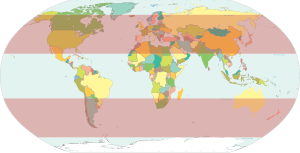Middle latitudes
This articleneeds additional citations forverification.(October 2019) |


Themiddle latitudes(also called themid-latitudes,sometimesmidlatitudes,ormoderate latitudes) are a spatial region onEarthlocated between theTropic of Cancer(latitudes23°26′10.0″) to theArctic Circle(66°33′50.0″), andTropic of Capricorn(-23°26′10.0″) to theAntarctic Circle(-66°33′50.0″).[1][2]They include Earth'ssubtropicalandtemperatezones, which lie between the twotropicsand thepolar circles.Weather frontsandextratropical cyclonesare usually found in this area, as well as occasionaltropical cyclonesorsubtropical cyclones,which have traveled from their areas of formation closer to theEquator.[3]
The prevailing winds in the middle latitudes are often very strong. These parts of the world also see a wide variety of fast-changing weather as coldair massesfrom the poles and warm air masses from the tropics constantly push up and down over them against each other, sometimes alternating within hours of each other, especially in theroaring forties(latitudes between 40° and 50° in both hemispheres)[citation needed],even though the winds on the northern hemisphere are not as strong as in the southern hemisphere, due to the large landmasses of North America, Europe and Asia.[4]
There are five types of mid-latitude climates consisting of:mediterranean,humid subtropical,oceanic,humid continentalandsubarctic.[5]
See also[edit]
References[edit]
- ^"Weather & Climate Change: Climates around the world".Education Scotland.Archived fromthe originalon 14 April 2016.
- ^Service, NOAA's National Weather."Glossary - NOAA's National Weather Service".w1.weather.gov.Retrieved2023-01-19.
- ^"Mid-latitudes | climateprediction.net".climateprediction.net.Archived fromthe originalon 2019-10-22.Retrieved2019-10-22.
- ^US Department of Commerce, National Oceanic and Atmospheric Administration."What are the Roaring Forties?".oceanservice.noaa.gov.Retrieved2023-01-19.
- ^"Midlatitude Climates (Group II)".geography.name.Retrieved2019-10-22.

